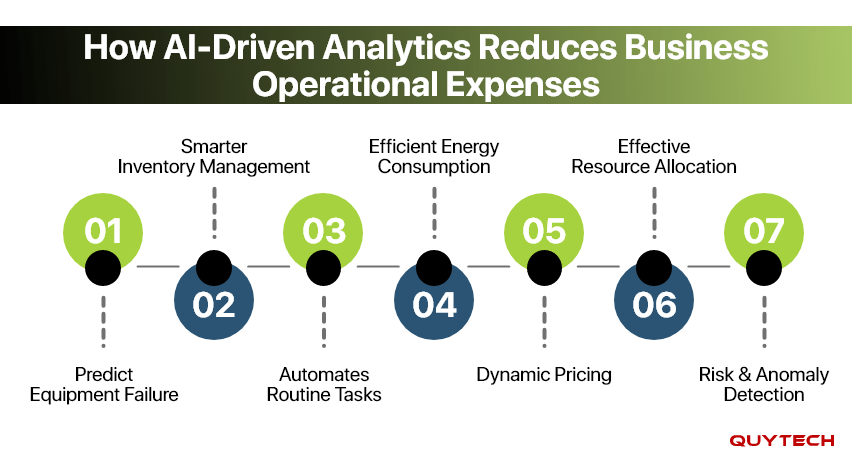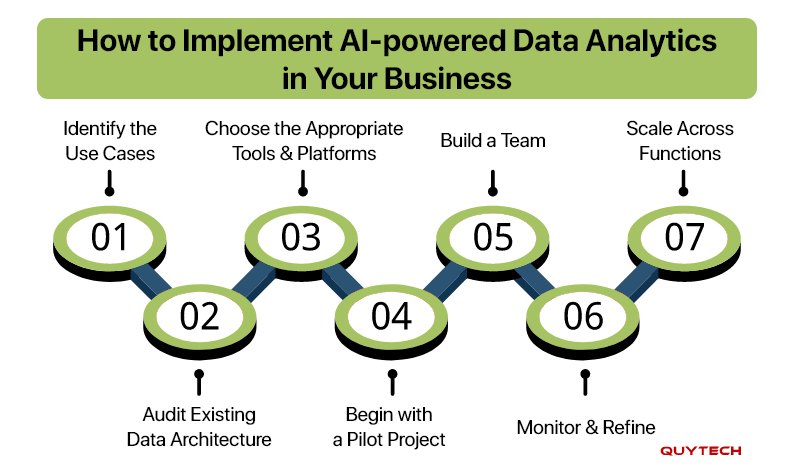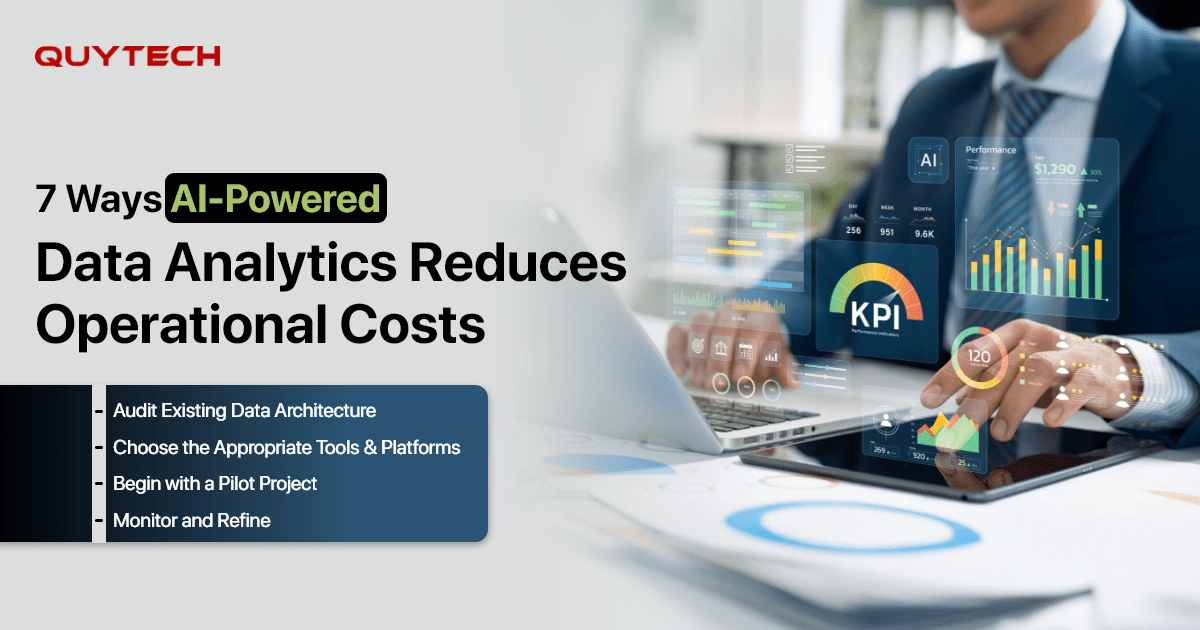Imagine working for months on creating an operations budget, but while implementing it, the costs exceed your expectations. Well, this is quite a common challenge for businesses of all sizes and types. The operational costs have a higher chance of going otherwise than the planned budget. To tackle these issues, many organizations come up with cost-cutting solutions that may result in a quality compromise.
Evolving problems need intelligent solutions. The current competitive business environment does not focus on simply acknowledging the issues, but works by knowing the root cause and patterns to prevent similar future situations. To tackle this all smartly, AI-powered data analytics comes into play. It turns data into actionable insights and helps enhance overall efficiency. If you are curious to know more about it, this blog is for you.
In this blog, you will discover the implementation process of analytics in business, along with the ways it helps businesses save operational costs.
AI and Data Analytics Market Stats
- Research done by McKinsey shows that the manufacturing industry improves production efficiency by 32%
- As per Harvard Business Review, the AI data analytics tools decrease the manual analysis time by 58%
- According to the report by PwC, AI analytics in finance reported a cost reduction of 65% in compliance operations.
- Based on a report by Gartner, AI-driven analytics are utilized by 72% of hospitals to improve operational efficiency.
- As per Capgemini, 30% of schools use AI-based data analytics for improving administrative efficiency.
- A report by Gartner shows that AI analytics improved HR recruitment efficiency by 41%.
How AI-Driven Analytics Reduces Business Operational Expenses
Balancing quality without exceeding the decided budget can be a hassle, but not anymore. The following are 7 ways in which data-driven decision making helps in operational cost efficiency:

1. Predict Equipment Failure
Sudden machinery or equipment failures occur at the most unexpected moments. These don’t just come with repair bills but also add to the cost of downtime, affecting operational efficiency.
With the help of historical data, patterns, sensory devices, and activity logs, predictive analytics tools can detect possible failures and breakdowns. This helps the businesses plan proactively without going through disruptions.
2. Smarter Inventory Management
Inventory planning plays an important role in any organization as it ensures that the stock level is balanced in a way that is neither overfilled nor understocked.
Data analytics, along with artificial intelligence tools, helps businesses maintain the right inventory levels. It does this with the help of sales trends, demand forecasts, historical patterns, etc. This saves costs incurred in storage, procurement, and loss of goods.
3. Automates Routine Tasks
Routine tasks like data entry, invoice processing, customer support interactions, etc., don’t just consume a lot of time but are very prone to inefficient handling and human error.
AI for data analysis automates these tasks and allows the workforce to invest their efforts in higher-value tasks. Adapting these not only saves time and money but also enhances accuracy.
4. Efficient Energy Consumption
Energy consumption is a very prominent expense in every other industry, be it running machinery in a manufacturing plant or using multiple computers in a technology-based enterprise.
AI-powered data analytics analyze energy consumption at different times and offer energy-saving insights by giving suggestions like shutting off idle machines or switching to energy management systems.
5. Dynamic Pricing
There’s never a price level perfect for dynamic market conditions. The pricing changes depending on the market demand forces. Offering high prices at times of low demand can lead to wastage, and offering discounts during high-demand times can lead to insufficient supply.
Data analytics helps in predicting the demands and setting prices based on that, resulting in cost efficiency.
6. Effective Resource Allocation
Resource allocation, when done properly, can help the business run smoothly, but when not allocated mindfully, it can result in losses too.
Analytics for business effectively allocates the workforce, machinery, or equipment based on the workload. With the help of data-driven decision making, the right person is allotted the right task, at the right time, and with the right assets required.
7. Risk and Anomaly Detection
Whilst performing regular operations, the chances of encountering certain risks and anomalies are always there. It could be anything from data breaches to regulatory non-compliance. These risks can significantly impact the business, but with the use of data analytics and artificial intelligence tools, they can be effectively detected.
AI-powered data analytics can detect potential threats, reducing the likelihood of losses and penalties that could harm a business’s reputation.
Read More: Integrating AI & Machine Learning into Business Operations
How to Implement AI-powered Data Analytics in Your Business
As beneficial as data analytics is, its implementation can be a bit tricky, but with the help of the following steps, you can implement it in your business:

1. Identify the Use Cases
The primary step begins with analyzing the areas that are not performing well but require high operational investments. This helps in directing the implementation of analytics into the low-performing areas instead of simply investing in overall efficiency, which could direct resources to areas that do not even require them.
2. Audit Existing Data Architecture
Assess your existing data by analyzing its quality, availability, etc. For AI-powered analytics to learn from your data, it needs to be properly structured and clean. If the existing data is well structured, integrating analytics for business becomes easy.
3. Choose the Appropriate Tools and Platforms
The next step involves deciding upon the suitable tools and platforms for implementing analytics. It includes deciding upon the analytics platforms for the data and AI models. Pick the ones that offer scalability and can be easily integrated into the existing system.
4. Begin with a Pilot Project
Start the implementation process by targeting a single inefficient area. It will help in analyzing the working of the system and checking if it works as planned or if deviations occur. This helps in taking corrective measures at an early stage.
5. Build a Team
Implementing AI-powered data analytics into your business is not something a single person can do. It requires collaboration between those who understand the business challenges and those with the technical skills to solve them. Without the right expertise, even the best ideas may fail to deliver results. That’s why partnering with skilled data scientists and analysts is essential for effective implementation.
6. Monitor and Refine
After the successful implementation of data analytics, check for possible deviations. See if it performs based on the planned performance, and if there are any shortcomings, take corrective action. Keep the system updated with the latest changes and train it from time to time.
7. Scale Across Functions
Once the performance of analytics is at par with the planned performance, scale it across other low-performing areas. Implement it in other departments as well and keep checking for possible improvements.
How Quytech Can Help Reduce Your Operational Costs
Quytech offers you a team of skilled data scientists and AI developers. With 14+ years of industry experience and thousands of successful AI project deliveries, we excel in providing personalized solutions.
Our team of experienced technology experts helps bring your ideas to life. We deliver AI-powered data analytics solutions tailored to your business needs by working closely with your team and maintaining clear communication throughout the process. With successful implementations like Praavi HRMS, we prove our capabilities in delivering reliable and secure AI-powered solutions.
Read More: Role of AI in Mobile Field Services in Day-to-Day Operations
Conclusion
In the current day scenario, where every little action performed is being digitized, cost efficiency should evolve as well. Traditional systems work but compromise on the quality, and that is why AI-powered analytics are the future.
With numerous benefits like effective resource utilization, cutting investment costs from unproductive operations, enhanced resource allocation, etc, data analytics not only serves the core function of reducing operational costs but also provides a competitive advantage to the business.
FAQ’s
No, while utilizing large amounts of data can be beneficial to enhance the accuracy of analysis, it can be applied to smaller datasets as well.
Yes, partnering with a reputable tech provider for data analytics ensures strong security. They implement robust data security techniques and adhere to industry standards.
No, data analytics is not just for large enterprises. It can be implemented and utilized by small and medium enterprises as well.
AI-powered data analytics can be implemented without in-house experts by partnering with data scientists and AI developers. You can hire developers and data scientists through outsourcing firms for technical support.



